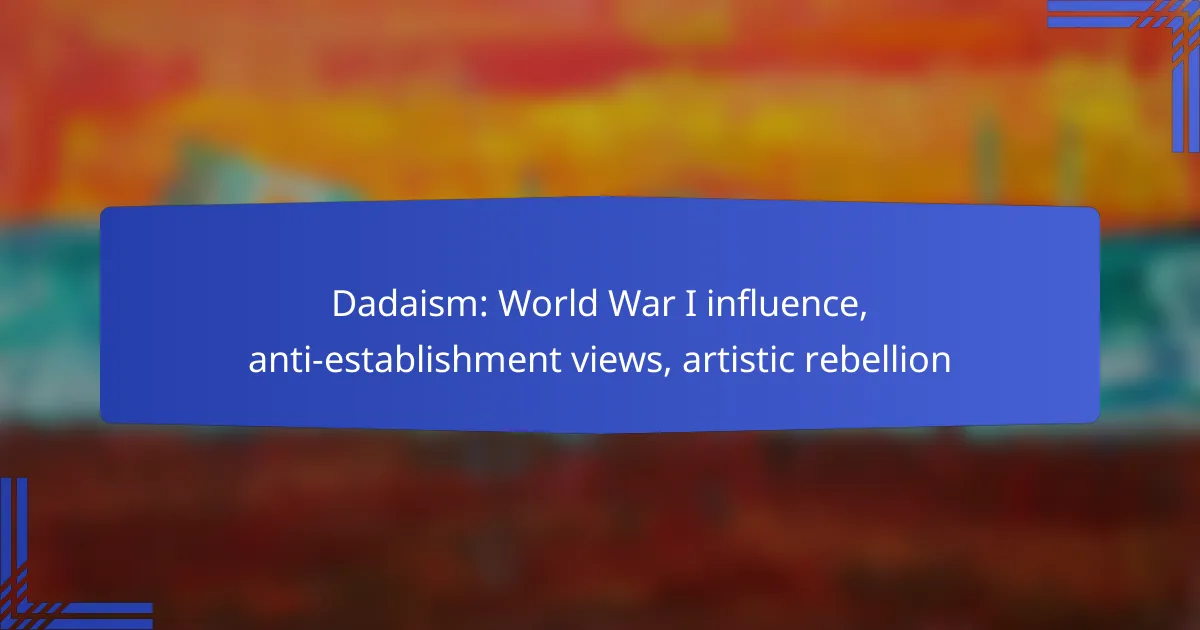Dadaism emerged as a radical artistic movement in response to the chaos and destruction of World War I, fundamentally reshaping the landscape of art and societal norms. Rejecting conventional aesthetics, Dada artists embraced absurdity as a form of protest against the values that contributed to the war, embodying a strong anti-establishment stance. This rebellion against tradition sought to provoke thought and challenge established conventions, reflecting a profound disillusionment with the world.
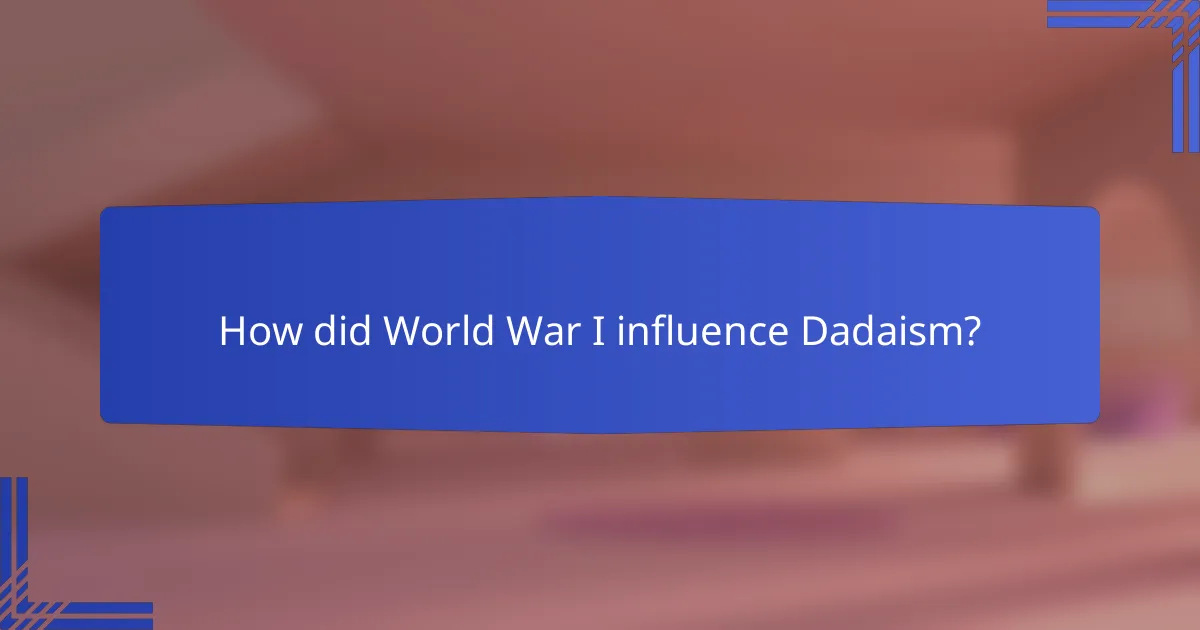
How did World War I influence Dadaism?
World War I had a profound impact on Dadaism, shaping its core principles and artistic expressions. The chaos and destruction of the war led artists to reject conventional aesthetics and embrace absurdity as a form of protest against the societal norms that contributed to the conflict.
Rejection of traditional values
Dadaism emerged as a direct response to the perceived failures of traditional values, particularly those associated with nationalism and rationalism. Artists sought to dismantle established norms in art, literature, and culture, favoring spontaneity and irrationality instead. This rebellion manifested in unconventional techniques and materials, such as collage and readymades.
By rejecting these traditional values, Dadaists aimed to challenge the status quo and provoke thought about the role of art in society. Their works often featured nonsensical elements, highlighting the absurdity of a world torn apart by war.
Impact of war trauma on artists
The trauma experienced by artists during World War I significantly influenced their creative output. Many Dadaists were directly affected by the horrors of the battlefield, leading to a deep sense of disillusionment and despair. This emotional turmoil found expression in their art, which often depicted chaos, fragmentation, and the grotesque.
Artists like Marcel Duchamp and Hannah Höch used their experiences to explore themes of identity and the human condition, reflecting the psychological scars left by the war. Their works served as a cathartic release, allowing them to process their trauma while critiquing the society that had led to such devastation.
Emergence of anti-war sentiment
Anti-war sentiment was a central tenet of Dadaism, as artists sought to voice their opposition to the violence and destruction of World War I. Through provocative art and performances, Dadaists aimed to raise awareness about the futility of war and its devastating consequences on humanity. Their works often included political commentary, challenging the glorification of conflict.
This anti-war stance resonated with a broader audience, as many were grappling with the aftermath of the war. Dadaism’s emphasis on absurdity and chaos served as a powerful critique of the ideologies that had fueled the conflict, making it a significant movement in the history of art and social commentary.
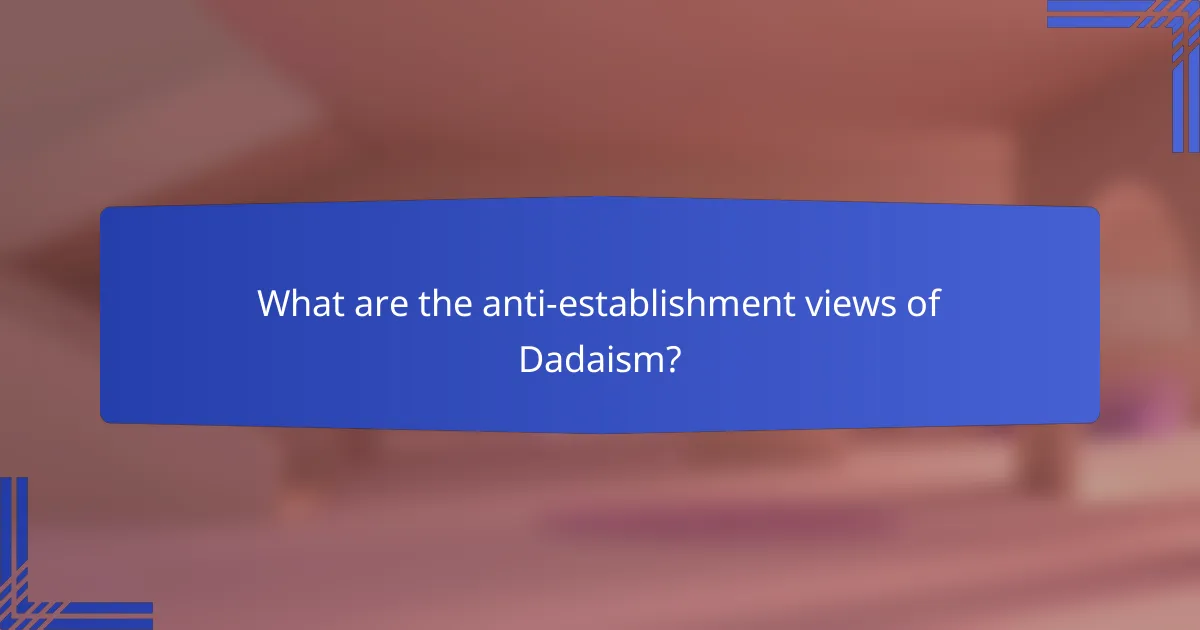
What are the anti-establishment views of Dadaism?
Dadaism embodies a strong anti-establishment stance, rejecting traditional values and norms in art and society. This movement emerged as a reaction to the devastation of World War I, challenging the established order and promoting a radical shift in artistic expression.
Critique of bourgeois society
Dadaists criticized bourgeois society for its materialism, conformity, and perceived moral decay. They believed that the values upheld by the middle class contributed to the war and societal suffering. Through provocative art and performances, Dadaists aimed to expose the hypocrisy of bourgeois culture.
Examples of this critique include the use of absurdity in their works, which highlighted the irrationality of societal norms. Dadaists often employed satire and parody to mock the pretentiousness of the bourgeoisie, encouraging viewers to question the status quo.
Emphasis on irrationality and chaos
Dadaism embraced irrationality and chaos as a response to the horrors of war and the failures of reason. By rejecting logic and traditional aesthetics, Dadaists sought to create art that reflected the tumultuous nature of human existence. This approach was a direct challenge to the rationalism that had dominated European thought.
Artworks often featured random elements, nonsensical combinations, and spontaneous creation, emphasizing the unpredictability of life. Dadaists believed that through chaos, they could liberate the human spirit from the constraints of conventional thinking and inspire a new way of seeing the world.
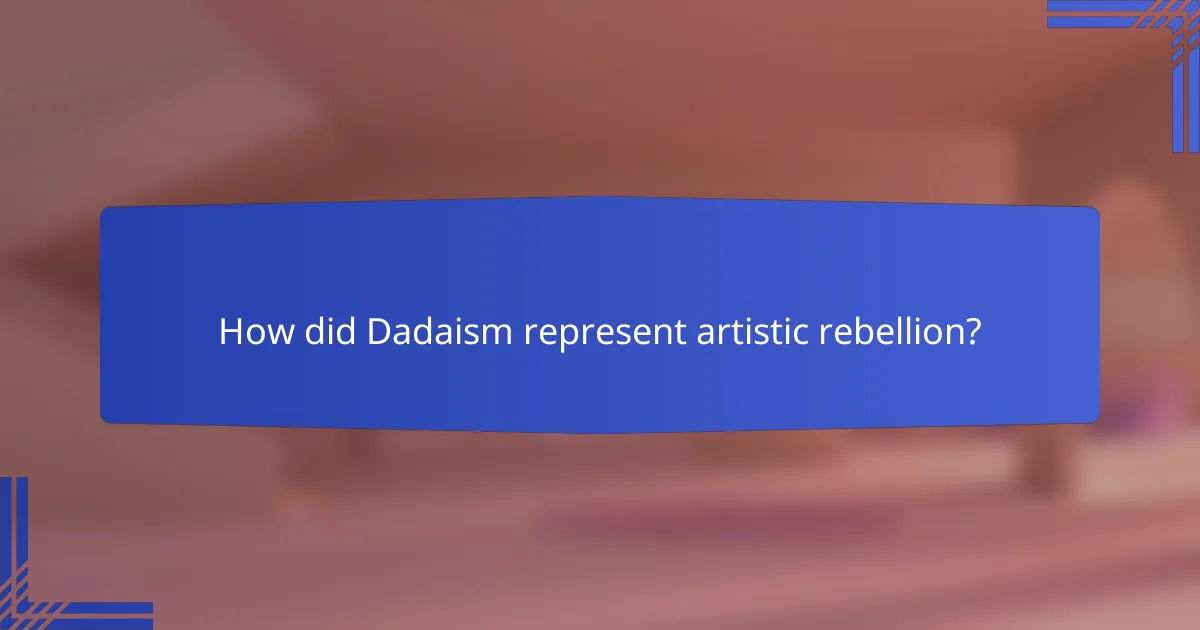
How did Dadaism represent artistic rebellion?
Dadaism embodied artistic rebellion by rejecting traditional aesthetics and societal norms, particularly in response to the devastation of World War I. This movement sought to challenge established conventions and provoke thought through absurdity and chaos, reflecting a deep disillusionment with the world.
Use of unconventional materials
Dada artists often employed unconventional materials to create their works, breaking away from traditional art supplies. Common items included found objects, scraps of paper, and everyday materials, which were repurposed to convey new meanings. This approach emphasized the idea that art could emerge from anything, challenging the notion of what constituted artistic value.
For example, Marcel Duchamp’s “Fountain,” a urinal presented as art, exemplified this radical shift. By using an ordinary object, Duchamp questioned the very definition of art and the role of the artist in society.
Performance art as protest
Performance art became a vital form of protest within the Dada movement, allowing artists to engage audiences directly and disrupt conventional expectations. These performances often included absurd actions, spontaneous acts, and provocative statements that critiqued political and social issues of the time.
Notable performances, such as those by Hugo Ball and Tristan Tzara, utilized poetry, music, and visual elements to create immersive experiences that challenged viewers’ perceptions. This interactive form of art not only highlighted the chaos of the era but also encouraged active participation in questioning authority and societal norms.
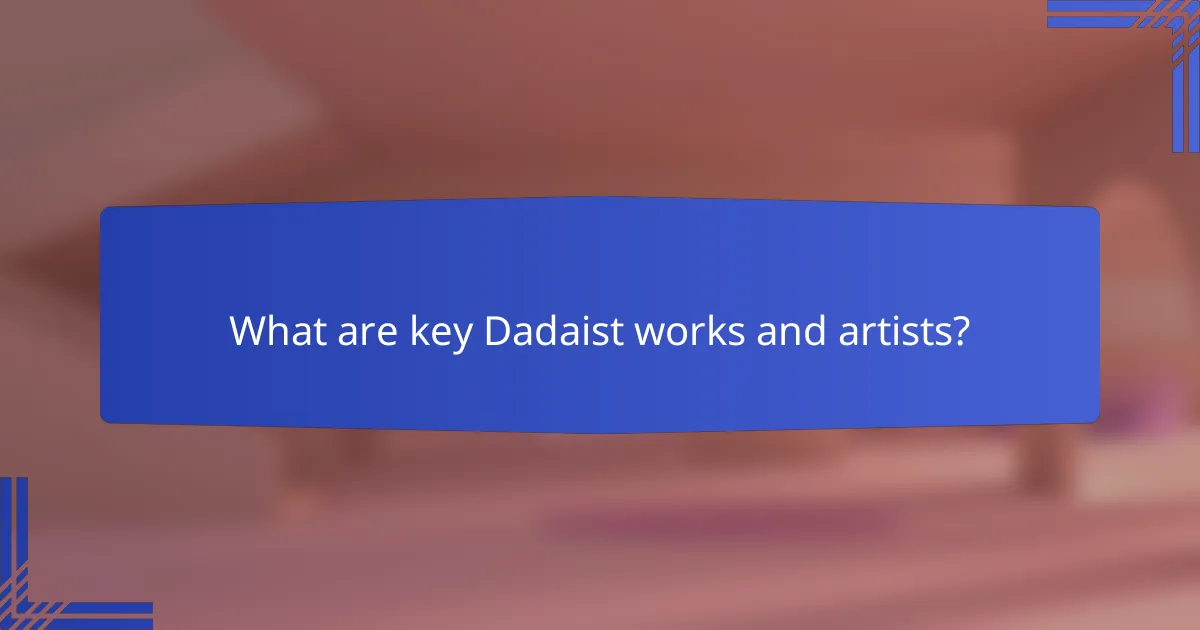
What are key Dadaist works and artists?
Key Dadaist works and artists exemplify the movement’s anti-establishment ethos and artistic rebellion against traditional norms. Notable pieces include Marcel Duchamp’s “Fountain,” Hannah Höch’s innovative photomontages, and Tristan Tzara’s provocative manifestos, each contributing significantly to the Dada movement’s legacy.
Marcel Duchamp’s “Fountain”
Marcel Duchamp’s “Fountain,” created in 1917, is a pivotal Dada artwork that challenges the very definition of art. This piece, a standard urinal signed “R. Mutt,” exemplifies the Dadaist rejection of conventional aesthetics and the embrace of everyday objects as art. Duchamp’s work provoked controversy and debate, forcing audiences to reconsider the role of the artist and the nature of creativity.
When analyzing “Fountain,” consider its impact on later art movements, particularly conceptual art. Duchamp’s idea that art could be defined by the artist’s intention rather than the object’s inherent qualities reshaped artistic discourse and opened doors for future experimentation.
Hannah Höch’s photomontages
Hannah Höch’s photomontages are significant contributions to Dadaism, particularly her work “Cut with the Kitchen Knife Dada Through the Last Weimar Beer-Belly Cultural Epoch in Germany.” Through the use of collage, Höch combined images from magazines and newspapers to critique societal norms and gender roles. Her innovative techniques and themes highlighted the chaos of post-World War I Germany and the fragmentation of identity.
Höch’s photomontages serve as a powerful reminder of the Dadaist goal to disrupt traditional narratives. By juxtaposing disparate images, she created visual dialogues that challenged viewers to question established social constructs and the media’s influence on perception.
Tristan Tzara’s manifestos
Tristan Tzara’s manifestos are foundational texts of the Dada movement, articulating its philosophy and objectives. In works like “Dada Manifesto” (1918), Tzara declared the movement’s rejection of logic and reason, promoting chaos and spontaneity as essential artistic principles. His writings encouraged artists to embrace absurdity and challenge societal norms through their work.
Understanding Tzara’s manifestos is crucial for grasping the Dadaist mindset. They not only served as rallying cries for artists but also provided a framework for the movement’s core beliefs, emphasizing the importance of individual expression and the rejection of traditional artistic constraints.

How did Dadaism influence later art movements?
Dadaism significantly shaped later art movements by promoting anti-establishment views and encouraging artistic rebellion. Its emphasis on absurdity and irrationality paved the way for movements like Surrealism and contemporary art practices that challenge traditional norms.
Connection to Surrealism
Dadaism laid the groundwork for Surrealism by introducing the idea of exploring the unconscious mind and dreams. Surrealists adopted Dada’s rejection of logic and embraced its techniques, such as collage and automatic writing, to create works that defy rational explanation.
Both movements share a disdain for conventional aesthetics, but Surrealism further developed the exploration of psychological themes, often incorporating symbolism and a deeper narrative structure. This connection highlights how Dada’s rebellion against established art forms influenced the evolution of Surrealist practices.
Impact on contemporary art
Dadaism’s legacy is evident in contemporary art, where artists continue to challenge societal norms and question the role of art itself. Many modern artists utilize Dada-inspired techniques, such as found objects and mixed media, to provoke thought and engage audiences in new ways.
Moreover, the Dadaist spirit of experimentation encourages contemporary creators to explore diverse mediums and unconventional methods. This ongoing influence fosters an environment where art is not just a product but a platform for dialogue and critique, reflecting current social and political issues.

What are the lasting legacies of Dadaism in the UK?
The lasting legacies of Dadaism in the UK include its profound influence on contemporary art movements and its role in shaping political discourse through artistic expression. Dadaism’s anti-establishment views continue to inspire artists and activists who challenge societal norms and conventions.
Influence on modern political art
Dadaism has significantly impacted modern political art by encouraging artists to use absurdity and satire as tools for critique. This approach allows for the exploration of complex social issues, often making them more accessible to the public. For instance, contemporary artists may employ Dada-inspired techniques to comment on government policies or social injustices.
In the UK, movements like the Situationist International and various street art initiatives have drawn from Dada’s legacy, using provocative imagery and performance to engage audiences in political dialogue. The use of public spaces for art has become a vital platform for expressing dissent and challenging authority.
Continued relevance in cultural critiques
The principles of Dadaism remain relevant in cultural critiques today, as artists continue to question the status quo and the commodification of art. By embracing chaos and irrationality, Dadaism encourages a re-examination of cultural values and societal expectations. This approach resonates with audiences who seek authenticity in a world often dominated by commercial interests.
In the UK, cultural critiques influenced by Dada can be seen in various forms, from literature and performance art to digital media. Artists frequently use irony and parody to highlight contradictions within contemporary culture, fostering a space for reflection and discussion among viewers.
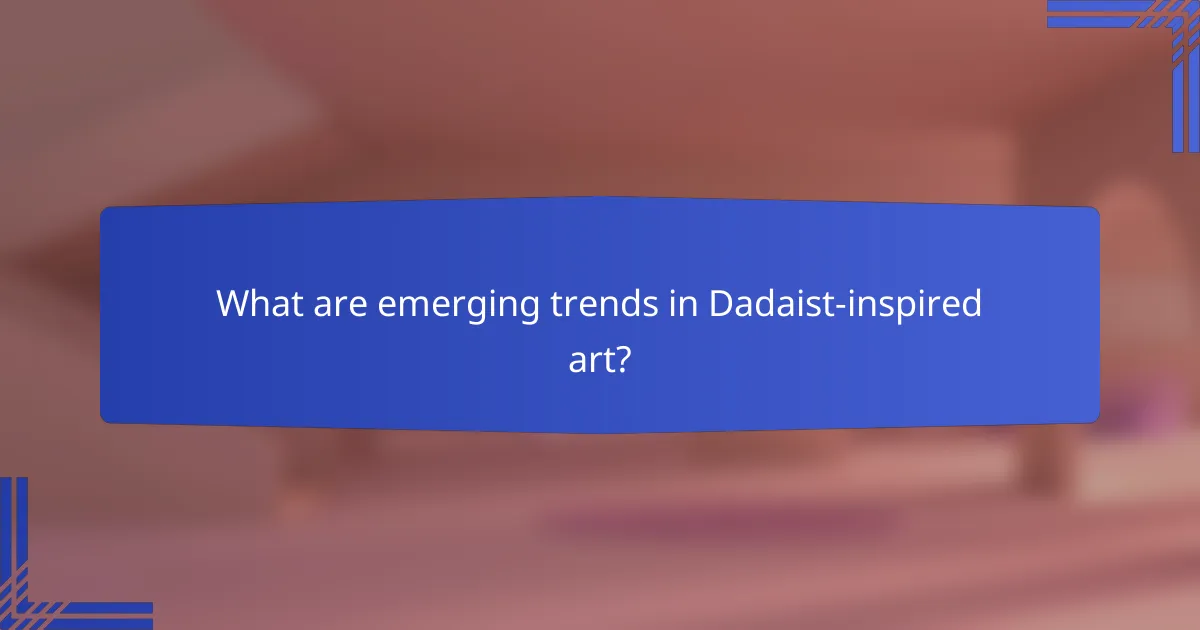
What are emerging trends in Dadaist-inspired art?
Emerging trends in Dadaist-inspired art reflect a blend of traditional anti-establishment views and modern technological advancements. Artists today are reinterpreting Dadaism’s core principles, using digital platforms and innovative techniques to challenge societal norms and provoke thought.
Digital Dadaism in online art
Digital Dadaism leverages online platforms to create art that resonates with contemporary audiences. Artists utilize social media, virtual galleries, and interactive installations to engage viewers in new ways. This trend often includes the use of memes and digital collages that echo Dada’s original spirit of absurdity and critique.
For example, online exhibitions can feature works that invite audience participation, allowing users to manipulate digital elements, thus blurring the lines between creator and viewer. This participatory approach enhances the Dadaist ethos of challenging traditional artistic hierarchies.
Reinterpretation of Dadaist principles
Today’s artists are revisiting Dadaist principles such as randomness, absurdity, and anti-art sentiments. They often incorporate elements of chance and spontaneity in their creative processes, reflecting a modern context that questions consumerism and societal values. This reinterpretation can be seen in various art forms, including performance art and street installations.
Moreover, contemporary Dadaists frequently critique political and social issues, using satire and irony to address topics like climate change and inequality. This approach maintains the original Dadaist goal of provoking thought and discussion through art.
Integration of technology in artistic expression
The integration of technology in artistic expression is a defining feature of modern Dadaism. Artists are using tools such as augmented reality (AR), virtual reality (VR), and artificial intelligence (AI) to create immersive experiences that challenge perceptions of reality. These technologies allow for innovative storytelling and interactive art forms.
For instance, AR can transform public spaces into dynamic canvases, where viewers can experience art in ways that were previously unimaginable. This technological integration not only enhances the viewer’s experience but also aligns with Dada’s disruptive nature, pushing the boundaries of what art can be.
